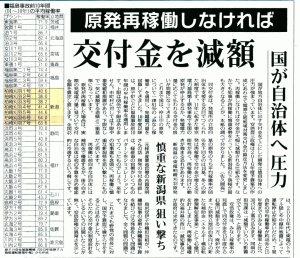Original Japanese written by staffer
The English below translated from the original Japanese by Heeday
The English translation edited by Rev. Dr. Henry French, ELCA
(Based on an article from the January 5th, 2016 edition of the Akahata newspaper)

▲Click the image and read the caption
Japan’s national government is applying pressure on local governments hosting a NPP to restart them, with a threat: “restart, or get a cut in the subsidy (from the national government).” Prime Minister Abe’s Cabinet, now preparing the FY2016 budget draft, has changed the method of calculating subsidies granted to local governments hosting a power source. In this revised method, a local government hosting a NPP, yet refusing to restart it, will suffer a drastic cut in the subsidy it receives from the national government. The prefecture to suffer most severely is Niigata Prefecture, whose Governor is reluctant to restart the Kashiwazaki-Kariwa NPP located in the prefecture.
The power source subsidy system was established in the name of financial assistance to local governments accommodating a power plant. Shortly after the meltdown of TEPCO’s Fukushima Daiichi of 2011, one NPP after another went idle throughout the nation. The issue emerged of what to do with power source subsidies, whose amounts were set to the quantity of power generated.
Until 2015, the national government applied a flat “deemed operation rate” of 81% to the idle NPPs in its calculation of the amount of power generated. From FY2016 onwards, it employs the average operation rate of each NPP over the decade prior to the Fukushima disaster. This rate has an upper limit of 68% and no lower limit for prefectural governments, while, for municipalities, there are some measures to alleviate changes in the subsidies they receive, such as a lower limit of the operation rate. Thus, this new calculation method is based on a double standard.
If a local government has restarted the NPP it accommodates, the subsidy it receives from the national government is re-calculated based on the actual power generated. Of all the 43 reactors in Japan, 18 have an average operation rate below 68%. Thus, many NPPs, if restarted, can bring in greater subsidies to their host municipalities than before. This might tempt many hosting municipalities to restart their NPPs.
TEPCO’s Kashiwazaki-Kariwa NPP, located in Niigata Prefecture, suffered many suspensions of operation during the 2000s, due to a major earthquake and for some technical problems covered up by TEPCO, among other reasons. Thus, its seven reactors had an average rate of operation of around 48%, more than 30% below the “deemed operation rate” applied until 2015. The Niigata Prefectural Government’s section responsible for issues with power source subsidies from the national government said, “We will face serious subsidy cuts, which should affect many things.”
~~ Mr. Shigeaki Koga, former official of Japan’s Ministry of Economy, Trade and Industry, said: ~~
“The new calculation procedures of NPP subsidies have been prepared by officials at the Ministry of Economy who, I suppose, tried many different simulations. Also, I suspect they were thinking of the prefectural governor election of 2016. Since the current governor of Niigata has been reluctant to agree to a restart of Kashiwazaki-Kariwa, I suspect that those officials intended to bring down the governor’s popularity before the election. In short, they intend to lure local governments into restarting their NPPs with attractive subsidies, while giving the cold shoulder to those reluctant to restart.”
Today, all over the world, many countries are switching to renewable energies, as well as to power generation and supply systems that are distributed, rather than centralized, and mainly powered by renewables.
Japan has nine times more renewable energy resources per unit area than Germany. Japan’s power generation with renewable energies is, however, only 1/9 of Germany’s. Since March 11th, 2011, Germany has shut down 41% of its NPPs, and has made up for 3/5 of the power loss with renewable energies. This drastic difference between the two nations comes not from human resources or technologies. The difference is ascribable to political, economic, and social systems.
Japan suffered great loss in the 2011 earthquake and tsunami and consequent NPP meltdown. One goal that it should now try to achieve is to enable its regions to obtain self-sufficiency in energy by taking advantage of renewable energy sources that each region finds easy to use.
Already, some small municipalities in Japan are striving to gain energy independence. Against such moves, the national government is trying to lure municipalities into restarting NPPs. We, the people, need to discover who are getting the profits from NPP restarts. We have to make the government follow the people’s will.
